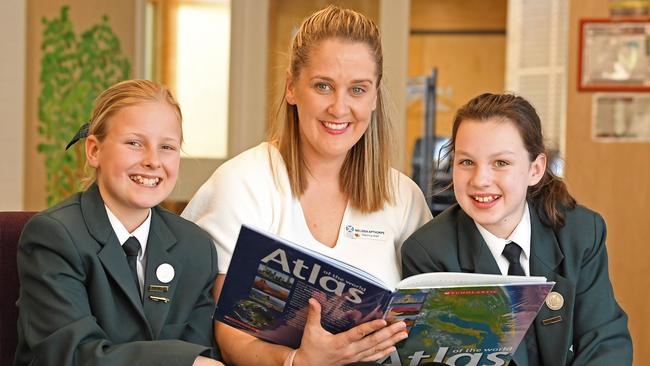Interactive list: Every SA school’s enrolment number and student/teacher ratio
Which schools are top of the class for student/teacher ratios? We’ve charted enrolment and teacher numbers for every SA school – public and private, primary and secondary – so you can see the drastic differences and how your kids’ school compares.
- Explore more schools data in our new Education section
- How we reward Advertiser digital subscribers every day
Some Adelaide public primary schools have twice as many students for every teacher as others, new data analysis reveals.
The Education Department says factors include government attempts to overcome disadvantage.
All mainstream SA schools have at least one full-time teacher for every 20 students.
Among public primary schools, Hawthorndene, Bridgewater, Ridgehaven, Lobethal, Craigburn, Nairne, Parkside, Grange and Flagstaff Hill have the highest student to full-time teacher ratios at 20.
By comparison, some in Adelaide’s northern and southern suburbs have ratios of just 10 or 11 students per full-time teacher.
This interactive database created by Advertiser.com.au reveals the student/teacher ratios and enrolment figures for every school – public and private – in the state.
The Education Department says all public schools are funded to ensure agreed average class sizes at every year level were not exceeded.
In each school, average class sizes should not be greater than 26 students across Reception to Year 2, 30 from Year 3-7, 29 from Years 8-10 and 26 in Years 11-12.
Schools are also funded according to seven categories of advantage and disadvantage, with a particular focus on helping disadvantaged schools keep junior primary classes small.
The ratios do not equate directly to class size for a range of reasons, including the fact that some primary schools have some specialist subject teachers in areas such as music, physical education or art.
They would help lower a school’s overall ratio without impacting on the size of, for example, a regular teacher’s Year 3 class.
Staff having different teaching loads depending on their other duties is another variable.
“Overall class sizes are influenced by how much funding a school receives based on its level of disadvantage, the programs on offer and how it deploys its resources,” a department spokesman said.
“For instance, schools with special units and special classes for disability will have lower ratios.
“Raw staff to student ratios don’t provide useful information on a school’s offering and we would recommend parents visit their local schools and talk to other families when deciding which school is right for them.”
However, Catholic Education SA said student/teacher ratio was a “reasonable raw measure” of class size.
“We aim to have class sizes that optimise student learning,” assistant director Michael Kenny said.
“Variables such as the needs and ages of the students, additional assistance available, and other relevant factors are all considered when forming classes.”
CESA said its enterprise agreement provided a “benchmark” for class sizes classes, so they “would normally not exceed” 25 students in Reception and Year 1, 29 for Years 2-6, 30 for Years 7-10 and 25 for Years 11-12.
The schools with the lowest student/teacher ratios are generally public special schools and remote Aboriginal schools.
* Note: Special schools and those with fewer than 20 students have been excluded from this list
Those aside, small regional schools predictably dominate the list of those with the lowest ratios.
In the Catholic sector, schools such as St Joseph’s Parish School at Gladstone, which had 42 students last year, have low ratios.
The highest ratios of 20 students per teacher are in Adelaide including St Mary’s Memorial School at Glenelg, St Teresa’s School at Brighton and St Thomas’ School at Goodwood.
Among independents, small alternative schools such as Dara School at Park Holme and OneSchool Global/Meridian School at Aberfoyle Park have lowest ratios. Some Lutheran schools have among the highest ratios, but at worst they have 18 students per teacher.
READ MORE
See the data insights for schools in Adelaide’s north, south, east and west
SA public schools’ most famous alumni (Part 1)
SA private schools’ most famous alumni (Part 1)

SMALL CLASSES, BIG CHOICES
Maintaining a low student/teacher ratio means “more effective, individualised learning” and makes for closer relationships in the classroom, a leading girls school says.
Glen Osmond private school Seymour College fulfils twin aims with its ratio of 9.4 students for every full-time teacher.
“We try to keep classes small to meet the expectation of our families — to offer a large and diverse range of subjects to meet the needs of our students,” principal Kevin Tutt says.
“This includes two senior programs, SACE and the IB Diploma.
“In having such a diverse range of subjects, girls are able to find what it is that they’re passionate about and pursue this interest through their time at the college.
“We also have a very diverse co-curricular program in sport and performance which needs to be staffed.”
The high-fee independent school tries to keep junior school classes between 20 and 22, middle school up to 24, and senior classes under 20.
Seymour extensively uses “team teaching” in its overhaul of middle schooling where most of the curriculum is merged into just two interdisciplinary “super subjects”, STEM (science, technology, engineering, maths) and GEM (global studies, English and media).
“Teachers work in teams in and across year groups to maximise student interest and teacher capability,” Mr Tutt said.
Seymour has broken down year level boundaries so Years 10 to 12 are considered a single cohort, studying at whatever level they are ready for in different subjects, and senior school students all have a staff “learning mentor”.
Some subjects have a “blended learning” model, with students spending half their time working online away from their teachers, to better prepare them for university.
